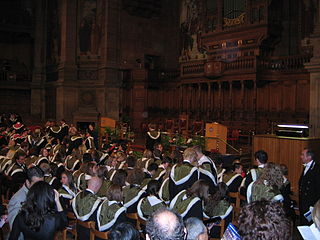Related Research Articles

The University of Oxford has a long tradition of academic dress, which continues to the present day.

Poplin, also called tabinet, is a fine wool, cotton or silk fabric that has a vertical warp and a horizontal weft. Nowadays, the name refers to a strong material in a plain weave of any fiber or blend, with crosswise ribs that typically give a corded surface.

The academic dress of Durham University has many similarities with that of other older British universities such as Oxford and Cambridge. Most colleges of Durham University insist on gowns being worn on formal occasions, including matriculation and formal halls (dinners); exceptions are Van Mildert, St Cuthbert's Society, Collingwood, Stephenson, St Aidans, and The College of St Hild and St Bede. Some colleges also insist on their being worn to Junior Common Room meetings, and they are often seen in college chapels. At formal halls, only gowns are worn and doctors normally wear their undress gowns; for more ceremonial occasions full-dress gowns and hoods are worn by graduates. Until 1990, the General Regulations of university 'recommended' the wearing of gowns by members of the university when attending divine service at the Cathedral – but this is now left to individual choice apart from at certain services. Gowns are also customarily worn to meetings of the university Senate by members of that body.
The academic dress of the former University of Wales was designed for the first graduations in 1893, and has as its main identifying feature a faculty colour scheme involving 'shot silks'.
The academic dress prescribed by the University of Bristol is a mixture of that prescribed by Cambridge and Oxford. Bristol has chosen, for graduates, to mainly specify Oxford-style gowns and Cambridge-style hoods. Unlike many British universities, the hood itself is to be "University red", lined with a specified colour. University red is defined to be Pantone 187. Bristol also specifies that undergraduates are to wear gowns "of the approved pattern" in certain circumstances, although the pattern itself is not specified. This is not too important since, in practice, undergraduates are only required to be gowned when graduating or at dinner as a member of Wills Hall.

Fashion in the period 1550–1600 in European clothing was characterized by increased opulence. Contrasting fabrics, slashes, embroidery, applied trims, and other forms of surface ornamentation remained prominent. The wide silhouette, conical for women with breadth at the hips and broadly square for men with width at the shoulders had reached its peak in the 1530s, and by mid-century a tall, narrow line with a V-lined waist was back in fashion. Sleeves and women's skirts then began to widen again, with emphasis at the shoulder that would continue into the next century. The characteristic garment of the period was the ruff, which began as a modest ruffle attached to the neckband of a shirt or smock and grew into a separate garment of fine linen, trimmed with lace, cutwork or embroidery, and shaped into crisp, precise folds with starch and heated irons.
Academic dress at the University of St Andrews involves students wearing distinctive academic gowns whilst studying at the University of St Andrews. Undergraduate gowns in Scotland were once common at all the ancient universities of Scotland, with each having its own distinctive style. St Andrews undergraduates wear either a scarlet gown if they are part of the United College and studying in the Faculties of Arts, Medicine and Science, or a black gown if they are part of St Mary's College and studying in the Faculty of Divinity.
The academic and official dress of the University of Warwick dates originally from the mid-1960s, shortly after the university's foundation. Despite persistent offers from Charles Franklyn the theatrical costume designer Anthony Powell was commissioned to design robes for officials and graduates of the university. Due to pressure of other work, and some apparent differences of opinion, Powell withdrew from the project, and the robes for graduates subsequently designed in consultation with J. Wippell and Company of Exeter, with Ede and Ravenscroft designing and making the robes for officials.
Academic dress of the University of London describes the robes, gowns and hoods which are prescribed by the university for its graduates and undergraduates.

Grosgrain is a type of fabric or ribbon defined by the fact that its weft is heavier than its warp, creating prominent transverse ribs. Grosgrain is a plain weave corded fabric, with heavier cords than poplin but lighter than faille, and is known for being a firm, close-woven, fine-corded fabric. Grosgrain has a dull appearance, with little luster in comparison to many fabric weaves, such as satin, often used for ribbons; however, it is comparatively very strong. Grosgrain fabric is most commonly available in black, but grosgrain ribbon comes in a large variety of colors and patterns. The ribbon is very similar to Petersham ribbon in its appearance, but it does not have the ability to follow the curves of a surface or edge the way that the latter does.
There are a number of universities in Queensland, Australia, all with distinct academic dress.
This page describes the different types of academic dress allowed at the University of Exeter. Definitions of the academic dress for the award holders and officials of the university are set out in the university's regulations.

Ottoman is a widthways-ribbed textile with pronounced, raised 'ribs' along its wale and course. Similar to grosgrain, Ottoman is known as a corded fabric, using a thicker yarn in the course rather than the wale to create raised stripes running across the width of the fabric.
The University of Leeds, like other universities in the United Kingdom and many other countries throughout the world, has its own unique system of academic and ceremonial dress for undergraduates, graduates and senior officials. As at most other universities, graduands will wear the gown, hood and hat appropriate to the degree they are about to receive. All of the graduates' hoods incorporate one or more shades of green, and the Doctors of Philosophy, Education and Clinical Psychology are unique in the UK in having a green full-dress gown.

Academic dress at the University of Edinburgh is compulsory at official ceremonial occasions, such as graduation and the installations of Rector and Chancellor, and otherwise optional, usually only worn for events.
The academic dress of the Royal Melbourne Institute of Technology (RMIT) are the robes, gowns and hoods prescribed by the Australian university for the administration, faculty, graduates, postgraduates and undergraduates of its Australian and Vietnamese branches. The academic dress of RMIT is described as similar to that of the University of Oxford in the United Kingdom. The current statute of academic dress was approved by the RMIT Council in 1980.

Academic dress of the University of Manchester describes the gowns, hoods and headwear which are prescribed by the university for its graduates and officers.

Graduates and associates of Imperial College London wear its academic dress. After gaining its independence from the University of London in 2007, graduates began wearing Imperial academic dress in 2008. The unifying colour for Imperial's academic dress is purple after the work by William Henry Perkin.
Academic dress at the University of Glasgow is worn at ceremonial events throughout the academic year. This primarily entails graduations, but includes Commemoration Day, church services, and the installation of Chancellors and Rectors of the University. The academic dress of all members of the University of Glasgow, including students, is regulated by the University Regulations. It shares many similarities with the other ancient universities of Scotland, most conspicuously that, unlike in the rest of the United Kingdom, headwear is only very rarely worn. Academic dress has been worn in the University of Glasgow since medieval times.
The academic dress of the University of Tasmania describes the formal attire of robes, gowns and hoods prescribed by the ordinance of academic dress of the University of Tasmania. The ordinance prescribes the Oxford style for the gowns and hoods for both undergraduate and postgraduate academic dress.
References
- ↑ Earle, Alice Morse (1917). Costume of Colonial Times.
- ↑ Harmuth, Louis (1915). Dictionary of Textiles.
- 1 2 Montgomery, Florence M. (2007). Textiles in America, 1650-1870. W. W. Norton & Company. ISBN 9780393732245.